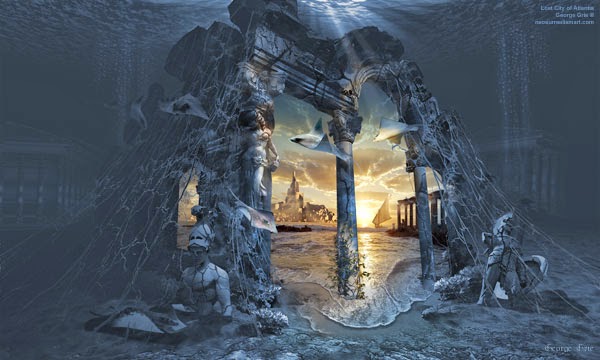The Lost City of Atlantis
Why is it that after
thousands of years, so many of us still search for the answer
to this mystery? Did it exist or didn't it. We can't seem to
let go of it, as if deep down we know it existed, as though
we possess some collective memory of it within our subconcious,
which doesn't let us accept it as myth. Like the ghost of someone
long gone that lingers on until the mystery of their death has
been resolved and they can finally be at peace, their story
having been told.
Ever since the first recorded history of Atlantis,
written by the Greek philosopher Plato over 2,360 years ago,
debate has raged as to whether or not Atlantis ever really existed.
Plato described it as an extraordinary Utopian society, thriving
around 9,600 BC, which valued peace, art and wisdom, possessed
advanced technological knowledge for the time, and enjoyed riches
beyond that of any subsequent civilization. The land was said
to have been very fertile, with abundant food, water, animals,
wood, and flowers. But, as the story goes, after several generations
of ruling the leaders became increasingly greedy and corrupt,
and started to wage war on their neighbouring countries. They
conquered parts of North Africa and Europe and were about to
attack Egypt and Athens, when the Athenian army valiantly drove
them back and defeated them. It is shortly after this victory
by the Athenians that violent and devastating earthquakes, and
the resulting tidal waves and floods, destroyed the Athenian
army, as well as the entire Island continent of Atlantis, submerging
it beneath the sea "in a single day and night".
The question is : Did Plato write this as a moralistic story,
or as a true historical account?
Plato's 2 writings
pertaining to Atlantis are the "Timaeus",
and the "Critias", written in 360BC, at which time
Plato would have been aged about 67 or 68. These are the earliest
known written records about the Lost Continent of Atlantis,
all other written references to Atlantis have been written since,
and have been based on these writings by Plato.
The
Timaeus and the Critias are actually written in the form of
dialogues between 4 main characters: Socrates (.Greek
philosopher, and Plato's teacher.),
Critias (.poet
& historian.), Timaeus
(.an Italian
astronomer.), and Hermocrates
(.a general
from Syracuse.). All
were real people.
The Timaeus includes only a passing reference to Atlantis, but
the second writing, the Critias, has a much more in depth description
of Atlantis leading upto it's downfall.
The story is told by the character Critias, who was possibly
Plato's maternal great-grandfather. Critias had heard the story
as a child from his own Grandfather, Critias the Elder, who
had heard it from his father Dropides, who had heard it from
his friend Solon, a great Athenian Law-giver reputed to have
been an honest and true man.
Solon had been told the story of Atlantis during his stay in
Sais, Egypt, by an elderly Egytian priest who claimed to have
acquired the knowledge directly from ancient records in his
keeping. After hearing of the account, Solon had intended to
record it himself, for posterity's sake, but for one reason
or another he never did.
Just for the record, Solon really did visit Sais, Egypt, although
the date Plato gives for this is about 20 years off. This at
least is indisputable fact.
The Egyptian records that the priest was referencing have to
this day never been found. But there are theories that hidden
in a hall underneath the sphinx, or in the top of the great
pyramid, is a secret chamber containing ancient records of invaluable
historical, and perhaps future, importance. Several excavations
have been attempted to find this secret room, but all have lead
to dead ends. It is unknown exactly where this rumor originated,
it may have been Edgar Cayce, an American psychic / clairvoyant
of the early 1900's, who predicted (sometime before his death
in 1945) that in 1998 a "Hall of Records" would be
found.
According to Cayce, the contents of the hall and the location
are as follows:
"A
record of Atlantis from the beginning of those periods when
the Spirit took form, or began the encasements in that land;
and the developments of the peoples throughout their sojourn;
together with the record of the first destruction, and the changes
that took place in the land; with the record of the sojournings
of the peoples and their varied activities in other lands, and
a record of the meetings of all the nations or lands, for the
activities in the destruction of Atlantis; and the building
of the pyramid of initiation, together with whom, what, and
where the opening of the records would come, that are as copies
from the sunken Atlantis. For with the change, it [Atlantis]
must rise again. In position, this lies -- as the sun rises
from the waters -- as the line of the shadows (or light) falls
between the paws of the Sphinx; that was set later as the sentinel
or guard and which may not be entered from the connecting chambers
from the Sphinx's right paw until the time has been fulfilled
when the changes must be active in this sphere of man's experience."
Source:
http://unxplained-factor.com/atlantis.htm






